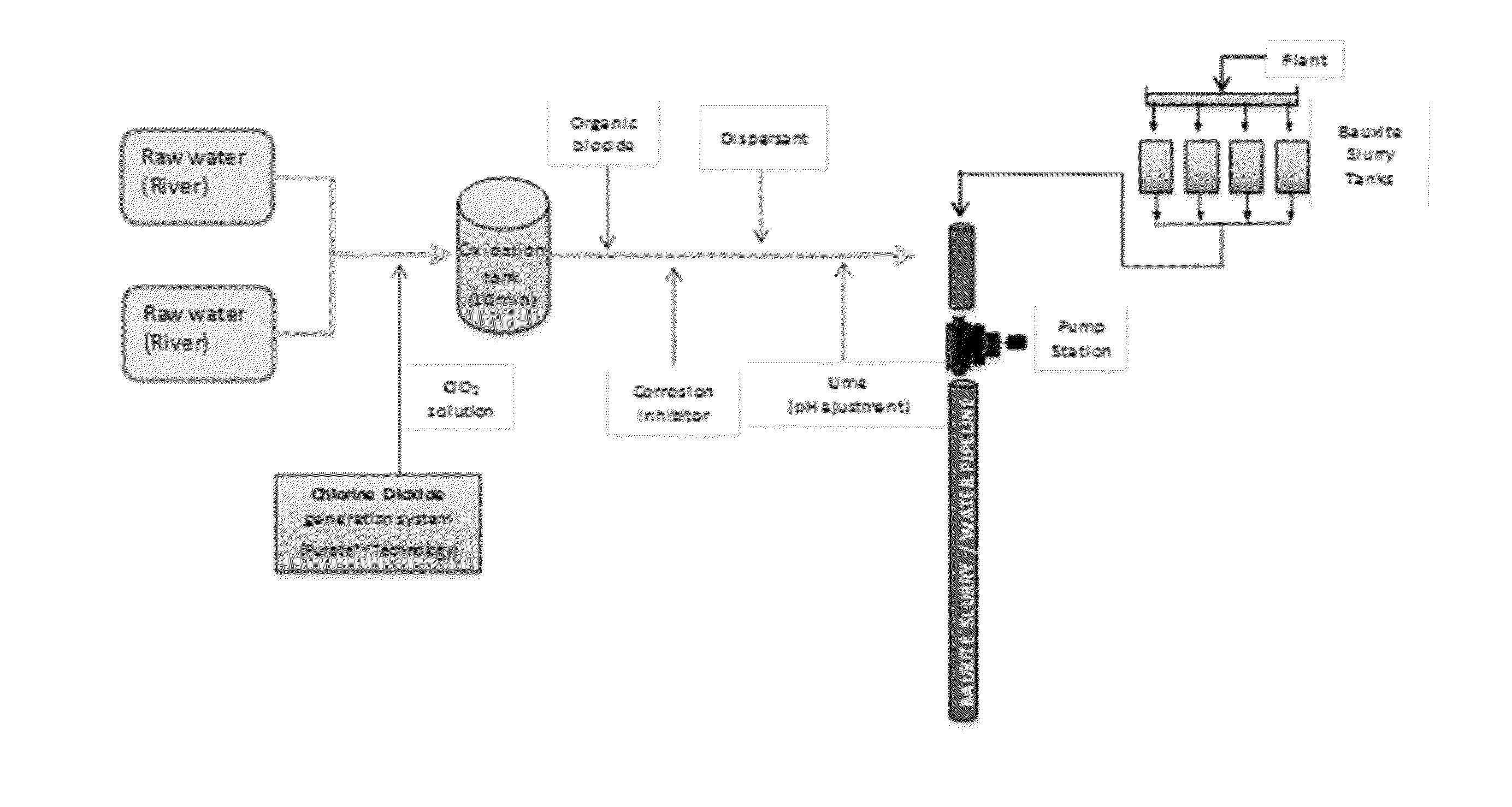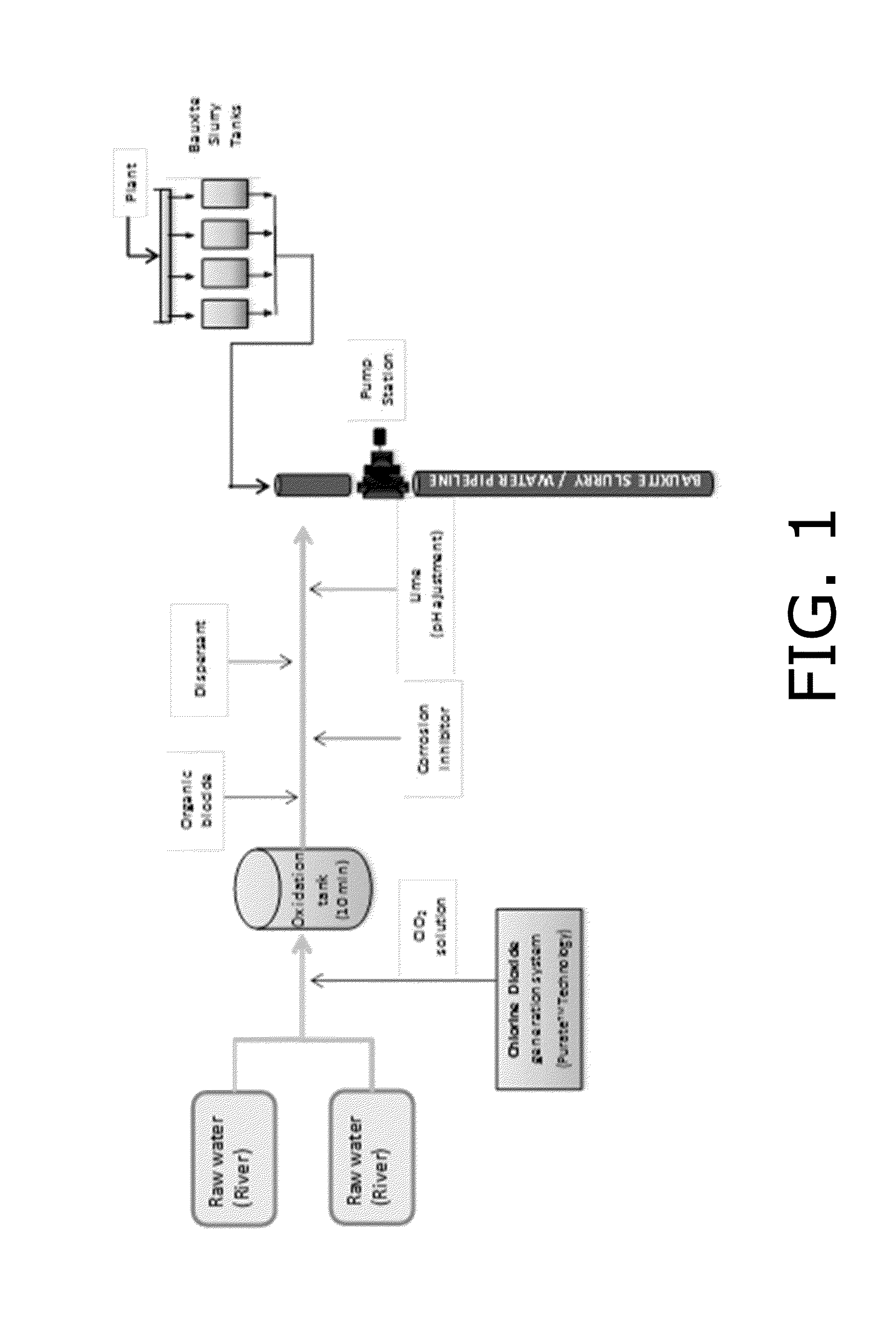Slurry biocide
- Summary
- Abstract
- Description
- Claims
- Application Information
AI Technical Summary
Benefits of technology
Problems solved by technology
Method used
Image
Examples
embodiments
[0036]At least one embodiment of the invention is directed to a method which minimizes the infestation of one or more microorganisms within pipelines during ore slurry transport. For a number of reasons including to prevent the formation of plugs and blockages due to settling of suspended particles within a pipeline, and also to prevent expansion-contraction type fractures or deformations due to changes in pressure differentials, slurry transport pipelines are often kept under flux for large periods of time (sometimes substantially most or essentially all, of the time). This often results in the pipeline needing to remain under flux even after the pipeline terminus (such as a refinery or smelter) has absorbed the maximum amount of slurry it can (or its operator wishes to) handle. As a result in order to remain under flux, slurry pipelines are sometimes filled with plugs. Because by definition plugs are low value bulk materials that are often discarded after passage through the pipel...
example 1
Microbiological Efficiency of Treatment with Oxidizing Biocide Compared to Non-Oxidizing Biocide
[0076]Two water samples collected directly of makeup water of a pipeline sourced form river water, were submitted to biocide treatment. One sample was highly contaminated with microorganisms (1700 CFU / mL) while the other was less contaminated (120 CFU / mL). The efficiency of treatment with oxidizing-biocide was superior in case on highly contaminated water (Test 3) while both treatments showed a satisfactory performance in case of less contaminated sample as showed in Table 1. There is a dramatic reduction in required dosage using oxidizing biocide (Cl2O) (Tests 3, 4 and 7).
TABLE 1Microbiological efficiency of treatment with oxidizingbiocide compared to non-oxidizing biocide only.Initial Initial Final Final CountCountCountCountTotal Sulfate Total Sulfate AerobicReducingAerobicReducingBacteria BacteriaDosageBacteriaBacteriaTest(CFU / mL)(CFU / mL)Biocide(ppm)(CFU / mL)(CFU / mL)1170030A500330102170...
example 2
Corrosion Rate Increase Due Presence of Oxidizing Biocide Cl2O
[0077]Tests were carried out using makeup water from a pipeline operator using river water that had not had any previous treatment. Tubular coupons made of C1018 mild carbon steel were used for the weight loss measurements. Coupons dimensions were: outside Some experiments had its pH adjusted using lime (Ca(OH)2).
Weight Loss Balance Experiments
[0078]An acceptable way to follow corrosion rate is through mass loss balance. This technique is suitable for both generalized and localized corrosion and can be described as follows. The tubular coupons received a surface treatment after each electrochemical experiment in order to remove any corrosion product eventually deposited on the surface before being weighted. The electrodes were copiously rinsed with taped water, smoothly brushed and then immersed into concentrated hydrochloric acid for 5 seconds. Finally, the electrodes were copiously rinsed with distilled water, dried and...
PUM
| Property | Measurement | Unit |
|---|---|---|
| Fraction | aaaaa | aaaaa |
| Fraction | aaaaa | aaaaa |
| Fraction | aaaaa | aaaaa |
Abstract
Description
Claims
Application Information
 Login to View More
Login to View More - R&D
- Intellectual Property
- Life Sciences
- Materials
- Tech Scout
- Unparalleled Data Quality
- Higher Quality Content
- 60% Fewer Hallucinations
Browse by: Latest US Patents, China's latest patents, Technical Efficacy Thesaurus, Application Domain, Technology Topic, Popular Technical Reports.
© 2025 PatSnap. All rights reserved.Legal|Privacy policy|Modern Slavery Act Transparency Statement|Sitemap|About US| Contact US: help@patsnap.com



